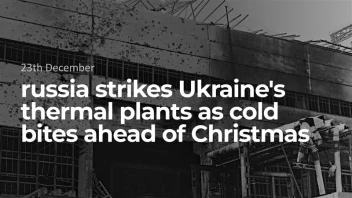In an interview with The Economist, executive director of DTEK Dmytro Sakharuk talked about the consequences of russia's massive attacks on Ukraine's energy infrastructure.
Russia’s losses on the battlefield have prompted it to attack Ukraine’s people. Since October 10th it has directed more than 200 cruise missiles and kamikaze drones at a crucial element of Ukraine’s civilian infrastructure: the electrical-power grid. And whereas Russia’s invasion has been badly planned, poorly executed and bereft of clear goals, its effort to turn off Ukraine’s lights appears competent and effective.
“I believe that some professionals from the energy sector of the Russian Federation helped their military,” says Dmytro Sakharuk, executive director of DTEK, Ukraine’s largest private power company. “They carefully selected targets; they did this in a very methodological way.”
Russia’s primary targets have been the electrical substations that link different parts of Ukraine’s grid together; some have been hit with as many as ten missiles. The aim is to chop the system into pieces so that power cannot be moved between different regions of the country to balance the load. In serious cases, this can even lead to much of the grid having to be shut down.
A second set of targets is the country’s power plants themselves. Those are bigger and harder to knock out, but as of last week at least 30% of the country’s power capacity had been damaged, according to UkrEnergo, the national-grid operator. Reducing capacity raises the risk that at peak demand the system could experience widespread blackouts and force some plants to shut down. In the worst case, says Mr Sakharuk, plants might lack the current needed to start up again. The blackout might last for a long time.
Ukraine’s grid has been linked to Europe’s since March, allowing European providers to supply current if Ukraine falls short. But if shutdowns make Ukraine’s grid too unstable, Europe might have to disconnect it, at least temporarily, in order to prevent that instability affecting its own grid; that would make Ukraine’s problems even worse. Sudden shutdowns would damage other infrastructure and heavy industry. For example, the ArcelorMittal steel plant in Kryvyi Rih, a city in eastern Ukraine, depends on the public power grid for the facility that turns coal into coke for its blast furnaces. If power were cut abruptly, its equipment would be wrecked, says Mauro Longobardo, chief executive of ArcelorMittal Ukraine. In cities such as Kyiv, meanwhile, water and sewage systems would shut down, along with neighbourhood heating systems. In below-zero temperatures pipes would freeze and crack.
To prevent this, power authorities are imposing rolling blackouts to keep demand safely below available supply. In important cities electricity is being turned off, neighbourhood by neighbourhood, for four hours at a time. Power companies have tried to set up websites to warn residents when the lights will go off, but sometimes blackouts are unpredictable. “They just cut the power, we don’t know when,” says Valera, who works at a bakery in Kyiv’s chic city centre. On the north side of the street, lights were shimmering and smooth pop music played in coffee shops, but along the south side restaurants relied on cash and candlelight.
Sakharuk says they could be swapped in. Circuit-breakers may be compatible too. But there are unlikely to be many such large components lying around, as they are usually built to order. Ordering new components from manufacturers could take anywhere from six months to three years. So Ukraine is asking Western firms to push it to the front of the queue, and take components they have ordered that are nearing completion.
Ultimately Ukraine needs better air-defences to protect its electrical installations from Russian attack. The new Iris-t missile systems which Germany is supplying, and the nasams system from Norway, will help. But Russia has large numbers of cheap Iranian Shahed drones, which are hard to detect by radar. Ukraine claims its air-defences are shooting down more than half of them. But judging by the damage inflicted on the electric grid so far, that is not enough.
DTEK puts the price of equipment it currently needs to replace at about $40m. Given that the company produces only a fifth of Ukraine’s power, the cost for all of Ukraine’s power industry will be much higher. The government cannot afford to pay for it. The European Bank for Reconstruction and Development has already allowed the country to repurpose a €150m ($148m) loan, meant for modernising the electric grid, to simply keeping it running. On October 24th it announced further loans of up to €3bn, partly for the power grid. Much more energy financing from foreign donors will be needed, Mr Povolotskiy says.
The West is already making plans for hundreds of billions of dollars in aid to rebuild Ukraine after the war. On October 25th donors are to gather in Berlin for a conference of experts on how to structure such aid. The conference will not result in binding decisions, but it is part of ongoing planning for what is expected to be one of the largest international aid efforts in history. Preventing Ukraine’s electricity grid from collapsing, and wreaking yet further damage on the rest of its infrastructure, seems a wise investment.







